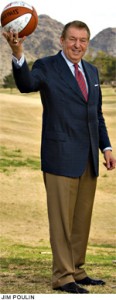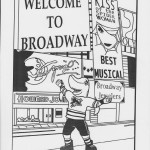 Jerry Colangelo (Owner – Phoenix Suns) . . . Confronted with skeptical political naysayers and self-anointed sports economics experts about the value of a new downtown arena in Phoenix, Colangelo retained us to conduct an economic impact study to provide him with an independent and rational tool that helped him argue his case before the Phoenix City Council. His vision and tough-mindedness have served the city well.
Jerry Colangelo (Owner – Phoenix Suns) . . . Confronted with skeptical political naysayers and self-anointed sports economics experts about the value of a new downtown arena in Phoenix, Colangelo retained us to conduct an economic impact study to provide him with an independent and rational tool that helped him argue his case before the Phoenix City Council. His vision and tough-mindedness have served the city well.
Yearly Archives: 2011
Creating Arena Football
Jim Foster (Inventor of Arena Football/Founder of Arena Football League) . . . The ex-National Football League executive retained us (including colleague Herb Briggin) to bring a fan perspective to refining the original rules of the new sport and to determine how its audience differed from that of the NFL and other major indoor sports so that marketing communications could be tailored to its unique characteristics and appeals.
The work not only helped Foster refine the rules but understand how the new sport’s target audience would differ from that of the National Football League, including the implications this would have for ticket pricing and packaging, event staging, media selection and messaging.
Precursor of Seat Licenses
John McMullen (Owner – New Jersey Devils) . . . Then also the owner of another client, the Houston Astros, McMullen retained us (including colleague Douglas K. Nelson) to (a) help re-launch his newly born New Jersey Devils National Hockey League club (formerly the Colorado Rockies) 60 days before its opening puck-drop, (b) restructure its pricing and season plan packaging 30 days after the original plan had been announced and (c) recapture his personal credibility with the New York media. Top tier season plan buyers were given access to the nearby Pegasus Club in return for a front-end long term loan to the club, inadvertently foreshadowing seat licenses.
How the first 30-60 days of a new ownership are managed can have lasting implications for the marketing of a sports franchise and how fans, media and prospects view not only owner intentions but the brand personality. Faltering first impressions are costly to reverse.
Out of Context Creativity
 Mascots can be leveraged to create stronger connections with young elementary school-aged children and their parents, conveying an engaging, new, unanticipated facet of the team brand. During the early development of the San Jose Sharks web site, we decided to translate graphic depictions of our popular mascot, S. J. Sharkie, into entertaining learning opportunities.
Mascots can be leveraged to create stronger connections with young elementary school-aged children and their parents, conveying an engaging, new, unanticipated facet of the team brand. During the early development of the San Jose Sharks web site, we decided to translate graphic depictions of our popular mascot, S. J. Sharkie, into entertaining learning opportunities.
We took him out of context to create an exciting new type of link with young fans and their families.
One of these executions was an “S.J.Sharkie Does New York” coloring book (we also developed a companion treatment for San Jose). The booklet of 17 pictures of San Jose Sharkie in famous New York City settings was delivered through our web site for printing out and coloring or painting and as a sponsored premium hand-out at a game.
 We had taken S.J.Sharkie to New York, shuttling him around Manhattan in a van and taking staged and impromptu photos of him, occasionally stopping traffic, frequently dealing with women of all ages who fell in love with him on first sight. Afterward, we cleaned the color out of the photos to generate the images you see here.
We had taken S.J.Sharkie to New York, shuttling him around Manhattan in a van and taking staged and impromptu photos of him, occasionally stopping traffic, frequently dealing with women of all ages who fell in love with him on first sight. Afterward, we cleaned the color out of the photos to generate the images you see here.
The thousands of nationwide and local downloads of the coloring book from the site suggest we hit an harmonic chord.
Turnarounds Require Economic and Marketing Discipline, Talent
Dan Finnane/Jim Fitzgerald (Owners – Golden State Warriors) . . . Upon acquiring the franchise from Franklin Mieuli, this hard-nosed business partnership who had recently sold the Milwaukee Bucks, retained us to help them reinvigorate waning interest in the Warriors and to recruit a new Director of Marketing. The national search led us to an upcoming marketing talent in his mid-20s making heartland waves in indoor soccer , Tod Leiweke, now CEO and co-owner of the Tampa Bay Lightning.
Armed with the fresh market and fan insights that we provided him, Leiweke deftly orchestrated a staff reorganization and reinvention of the Warriors franchise.
Afghan Initiative
 One of the image-building programs we conceived and implemented for Strikeforce entailed outfitting our Bagram and Kandahar air bases in Afghanistan with a trove of Strikeforce-branded mixed martial arts training equipment. The military is a major segment of MMA tv/web-based viewership and participation.
One of the image-building programs we conceived and implemented for Strikeforce entailed outfitting our Bagram and Kandahar air bases in Afghanistan with a trove of Strikeforce-branded mixed martial arts training equipment. The military is a major segment of MMA tv/web-based viewership and participation.
Not a traditional function of the Strikeforce organization, thinking globally in this manner, our interim operating role and outside experience-based perspective played a critical role bring this effort about without taxing the lean operating staff.
Working with military intermediaries at Langley AFB near Washington D.C., an extension of Pentagon, and with the enthusiasm of Strikeforce CEO Scott Coker, I worked for ten months to deliver MMA gear into the war zone bases to strengthen troop battle readiness and build their morale.
Produced for us in Bangkok, Thailand by Fairtex, where the summer 2010 unrest delayed production, the equipment was deployed directly to the bases by . . . FedEx! MMA training sessions there, as frequently as three times a week, had been limited to grappling absent the benefit of protective and workout gear.
The palletized shipments included Muaythai banana bags, mitts, Thai curve pads, training and combat gloves, sparring head guards, shin pads and a supply of EA Sports “MMA” video games.
As an extension of the initiative, Strikeforce invited attendees, competitors and exhibitors at the 23rd Arnold Fitness Expo between March 4-6, 2011 in Columbus, Ohio to visit its booth and sign onto “Messages from Home” placards to demonstrate support of the United States troops. They were expedited to Bagram, Kandahar and Langley and staged in high visibility locations. Feedback from the troops at all levels inspired and humbled us.
There are now Strikeforce-equipped and comprehensive MMA-based programs in place at the two primary Afghanistan bases benefiting air, marine and army personnel.
Horse Racing Insights Pay Off
Edward DeBartolo Sr. Owner – Thistledown/Louisiana Downs/Balmoral (subsequently sold before opening of Remington in Oklahoma City) race tracks . . . Hired our firm to develop a factual understanding of patron attitudes, behavior, satisfaction levels and geographic dispersion so that marketing efforts could more effectively address how to increase the visitation frequency of light attenders and profitable high spenders, affectionately called “degenerates”. He immediately grasped the parallel between building shopping mall traffic (the foundation of his business interests) and attracting/serving race track patron
Understanding the Hispanic Community
Jackie Autry (Owner – California (now “Los Angeles”) Angels) . . . Not satisfied with having attendance stalled, win or lose, at the 2.5 million level, Autry retained us to understand the decision making dynamics of light and heavy attending Angels fans, including focused attention on Hispanic communities, in order to increase marketing and ticket sales effectiveness and productivity. Her customer service consciousness, bred of her experience in banking, was among the highest in the entire pro sports industry.
The structure of the Hispanic community, reinforcing what we had learned when working with the Houston Astros, highlighted the importance of engaging community leaders, informal and formal, including religious, political and small business principals. A key hurdle we discovered that had to be overcome was the issue of “trust” and “commitment to diversity” reflected in the team’s and playing facility’s hiring practices.
New Data Base Building/Fan Insight Tool
Dick Vertlieb (General Manager – Golden State Warriors) . . . Weeks after taking this position, he became my first client in pro sports . Moving to the Bay Area from Seattle, he sought to understand his fans so that he could better direct his ticket sales, advertising, promotions, public/media relations, game staging and community development functions.
In response, I drew on insight from a meeting with Jack Kent Cooke, then owner of the Los Angeles Lakers and Kings, who was introduced to me by Alan Rothenberg, subsequently major domo of the U.S.-staged FIFA World Cup soccer event in 1994, conceiving what became known as the Audience Audit™ , the first self-administered marketing research tool of its kind in the sports world. That season the Warriors won the NBA Championship and Vertlieb was selected NBA “Executive of the Year” by The Sporting News. Dame Fortune had smiled. And a career was born.
The tool provided us with quantitative insights into decision making behavior, attitudes and the seven mutually exclusive attender combinations that accounted for two-thirds of attendance, helping us concentrate resources, messaging and experiential changes at the arena on their preferences.
In subsequent years have applied the same tool to assist clients seeking to build live event audiences across a spectrum of sports, entertainment and arts industries.
Messaging Master and Management Talent Scout
Tal Smith (President – Houston Astros) . . . one of the most highly regarded Major League Baseball assessors of on-field talent and a long-time salary arbitration preparation expert , Smith also knew how to communicate a team building philosophy that the media and fans accepted when the team was in a re-building mode on the field. His “strong arms/tight defense” served the Astros well during my work with the club, my first MLB client, an engagement which at Smith’s request included helping convert a recently retired successful pitcher into an effective ticket sales manager . . . Larry Dierker, later a color broadcaster and Manager of the Astros.